Silicified curcumin microspheres Combats cardiovascular diseases via Nrf2/HO-1 pathway
IF 18
1区 医学
Q1 ENGINEERING, BIOMEDICAL
引用次数: 0
Abstract
Diabetes and chemotherapy frequently give rise to severe cardiovascular complications, including chemotherapy-induced cardiotoxicity and diabetes-associated vascular remodeling. Nevertheless, the precise epidemiological features of these cardiovascular ailments remain incompletely elucidated, resulting in a dearth of effective therapeutic strategies in clinical settings. To tackle this intricate challenge, we have delved extensively into database resources, conducted comprehensive analyses of pertinent epidemiological data, and designed silicified curcumin (Si/Cur) microspheres as a novel therapeutic approach for cardiovascular diseases. By harnessing the alkaline microenvironment generated by silicon (Si), Si/Cur markedly elevates the bioavailability of curcumin (Cur). Further investigations have elucidated that Si/Cur exerts its therapeutic actions primarily via the Nrf2/HO-1 signaling pathway, effectively suppressing vascular remodeling and mitigating myocardial injury, thus disrupting the vicious cycle of persistent cardiovascular damage. In conclusion, this study integrates clinical cohort research to dissect epidemiological characteristics, directs the design and application of biomaterials, and paves the way for a novel and efficacious therapeutic avenue for the management of cardiovascular diseases.

硅化姜黄素微球通过Nrf2/HO-1途径对抗心血管疾病
糖尿病和化疗经常引起严重的心血管并发症,包括化疗引起的心脏毒性和糖尿病相关的血管重构。然而,这些心血管疾病的确切流行病学特征仍然不完全阐明,导致临床环境中缺乏有效的治疗策略。为了解决这一复杂的挑战,我们深入研究了数据库资源,进行了相关流行病学数据的综合分析,并设计了硅化姜黄素(Si/Cur)微球作为心血管疾病的新治疗方法。通过利用硅(Si)产生的碱性微环境,Si/Cur显著提高了姜黄素(Cur)的生物利用度。进一步研究表明,Si/Cur主要通过Nrf2/HO-1信号通路发挥其治疗作用,有效抑制血管重构,减轻心肌损伤,从而打破心血管持续损伤的恶性循环。总之,本研究结合临床队列研究来剖析流行病学特征,指导生物材料的设计和应用,为心血管疾病的管理开辟一条新的有效的治疗途径。
本文章由计算机程序翻译,如有差异,请以英文原文为准。
求助全文
约1分钟内获得全文
求助全文
来源期刊

Bioactive Materials
Biochemistry, Genetics and Molecular Biology-Biotechnology
CiteScore
28.00
自引率
6.30%
发文量
436
审稿时长
20 days
期刊介绍:
Bioactive Materials is a peer-reviewed research publication that focuses on advancements in bioactive materials. The journal accepts research papers, reviews, and rapid communications in the field of next-generation biomaterials that interact with cells, tissues, and organs in various living organisms.
The primary goal of Bioactive Materials is to promote the science and engineering of biomaterials that exhibit adaptiveness to the biological environment. These materials are specifically designed to stimulate or direct appropriate cell and tissue responses or regulate interactions with microorganisms.
The journal covers a wide range of bioactive materials, including those that are engineered or designed in terms of their physical form (e.g. particulate, fiber), topology (e.g. porosity, surface roughness), or dimensions (ranging from macro to nano-scales). Contributions are sought from the following categories of bioactive materials:
Bioactive metals and alloys
Bioactive inorganics: ceramics, glasses, and carbon-based materials
Bioactive polymers and gels
Bioactive materials derived from natural sources
Bioactive composites
These materials find applications in human and veterinary medicine, such as implants, tissue engineering scaffolds, cell/drug/gene carriers, as well as imaging and sensing devices.
 求助内容:
求助内容: 应助结果提醒方式:
应助结果提醒方式:


